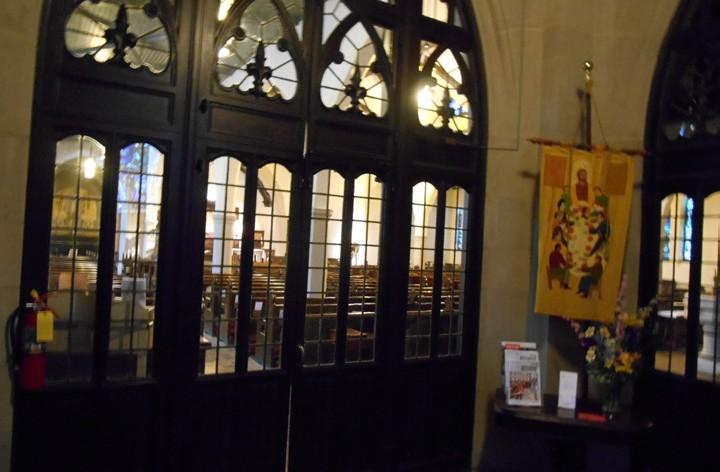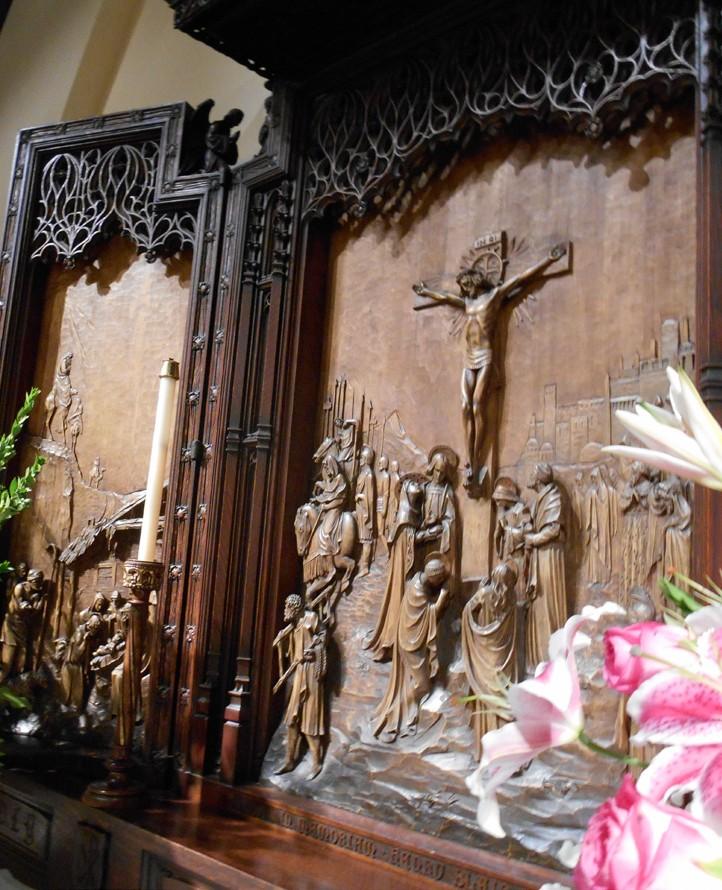OUR HISTORY
ORAL HISTORY OF THE PARISH
by Dorothy Ramm
St. Chrysostom’s history dates to its founding as an Episcopal parish in 1893. In early 1894, the congregation purchased the current site. The initial building went under extensive remodeling in 1925 when the chapel and the tower were built. Much of the stained glass was installed between 1925-1928. All windows were created by the Boston-based stained glass master Charles Connick. Connick was inspired by the Gothic style of French stained glass, which he preferred over the contemporary Tiffany styles.

NARTHEX
The stained glass window in the narthex (the vestibule through which one enters the main worship area or nave) was given by The Rev. Dudley Stark (Rector 1932-50) and his wife Mary in memory of their son Gregory, who was killed in Germany in WWII. It depicts the “War in Heaven” passage from Revelation 12 in which St. Michael and his angels fight against the dragon. Installed in 1947, this is the last window designed by Connick.

NORTH ENTRANCE
The window in the north entrance is a memorial to Wallace and Edith Owen, originally from Canada. It incorporates the church flags of the United Stated and Canada and features the crest of the Royal Canadian Mounted Police. Christ is depicted holding a model of a verse of Saint Chrysostom saying, “The Spirit and the bird say, come.”

SOUTH AISLE WALL
The Saint John the Baptist window is a memorial to William D.C. Street, a member of the vestry from 1901-1918. A banker, and the son of a Canadian priest, he was dedicated to St. Chrysostom’s and to the Diocese.
The Saint Mark window depicts the judgment of Solomon and Christ stilling the storm.
The Saint Luke window was the first window installed in the church. The window is a memorial to Chester Chapin who died at 14.
The Angel of Praise window was a gift of parishioners Thomas and Elizabeth Hind in 1893.

CRANE CHAPEL
The Chapel was given by Mrs. Florence Crane in memory of her husband Richard as part of the 1925 expansion. The mosaic of our patron saint, Saint John Chrysostom, is a copy of one in the Hagia Sophia in Istanbul. John Chrysostom was Archbishop of Constantinople and a 4th century theologian famed for his extraordinary preaching, earning him the designation “honey-tongued”. In his honor, the parish has incorporated beehive motifs throughout the church.
The Crane Family also donated the bell tower and carillon directly above the chapel.

ALTAR
The high altar was dedicated on November 13, 1927. The beautiful carved reredos is said to have been commissioned for another church but then was acquired by St. Chrysostom’s.
To the right of the altar is the Good Shepherd Aumbry, the cabinet which holds bread, wine and chalices for Holy Eucharist. It is a memorial to a parishioner killed in WWII in April 1945.
To the right of the forward altar table, the lectern featuring a large eagle was designed and manufactured by Gorham and was exhibited at the 1893 World’s Fair.

Brooker Chapel
The Brooker Chapel is generously given in memory of Nancy Neumann Brooker (1942-2003) by her husband, parishioner T. Kimball Brooker and their three children, Isobel, Vanessa, and Kim. Nancy Brooker served as our senior warden from 1995-1997 and was previously junior warden and search committee chair.
The Brooker Chapel features the Ascension Panel given by Dorothy Eckhart Williams in memory of her father Bernard Eckhart, who died on Ascension Day 1931.
The Brooker Chapel was created in 2012 to fill the space left when St. Chrysostom’s purchased a new organ and moved its location from the front to the back of the church in 2004. It now balances the Crane Memorial Chapel on the south side of the altar.

NORTH AISLE WALL
The north aisle wall contains four beautiful stained glass windows representing women saints.
- The Virgin and Child window is given in memory of Dorothea Hamilton Felton, a member of the Daughters of the Revolution and Colonial Dames. Symbols of both organizations are illustrated in this window.
- The Saint Elizabeth and John the Baptist window depicts little John in a miniature camel’s hair coat.
- The Saint Mary of Bethany and Saint Mary Magdalene window pays tribute to Mary. One of the scenes depicts the raising of Lazarus.
- The Saint Martha window pays tribute to Jesus’ friends Mary and Martha. Martha is illustrated with a green halo signifying an active life. Other scenes depicted in the window depict Martha killing a dragon and villages of Cadiz, Spain.

CENTER AISLE
At the ceiling, the stained glass windows on the north side of the church depict the four major prophets: Isaiah (tongs and coal), Jeremiah (scroll and pen), Ezekiel (building representing the Temple), and Daniel (lion).
The stained glass windows on the south side are the traditional symbols of the four gospel writers Mathew (man), Mark (lion), Luke (ox), and John (eagle).

ORGAN AND TE DEUM STAINED GLASS WINDOW
Turning from the center aisle and facing east, one sees the beautiful Fisk Organ and the Te Deum stained glass window.
This window, dedicated on Thanksgiving Day 1927, depicts passage from the Te Deum Laudamus canticle. It was given by William and Joan Chalmers in memory of their children, Thomas and Joan who died in April 1923. Thomas was a mining engineer who served in WWI. His death was war-related. Joan was active in the WWI Red Cross unit whose insignia is included in the window. Note that the left face in the faces of Holy Innocents in the lower central panel is a different color. In 1969, when the trial of 1968 Democratic Convention protest leaders was about to begin, a group massed at the south end of Lincoln Park, running through the streets south of the park throwing stones through windows of buildings damaging this panel.
In 2004 our Fisk Organ, Opus 123, arrived from Gloucester, Massachusetts. The pipes were carried into the church by 102 parishioners and friends. The organ was finished in February 2005.

CARILLON
Installed in 1927, the Richard Teller Crane Memorial Carillon is one of the oldest in the country and the second oldest in the Midwest. The 43 bells were cast and installed by the bell foundry Gillett and Johnston of England. Gillett and Johnston bells are known for their well-tuned, full tone and these bells are no exception. The 43 bells are tuned to a chromatic scale and range from 5600 pounds to 9 pounds. Each bell clapper is connected to a baton or pedal on an oversized keyboard located in the tower. With both fists and feet in action, carillon performers can play a large range of repertoire from hymns to classical arrangements to Christmas carols. This basic instrument mechanism dates from the early 16th century in Belgium and the Netherlands.
While the original church structure was encased in simulated stone, the bell tower, constructed specifically for the carillon, was made from solid stone to carry the heavy weight of bronze. Behind the vertical openings of the tower is the bell chamber with the bells stacked like a wedding cake; the biggest bells on the bottom with the smallest bells on top. The size of the openings and the angle of the louvers—the wooden panels—determine the acoustics on the ground. An optimal opening size and louver angle will create the right volume of music with no one bell too loud or too soft. The height of the tower also affects the acoustics; this tower height of 105’6” helps create an optimal volume for listeners in the church courtyard.
